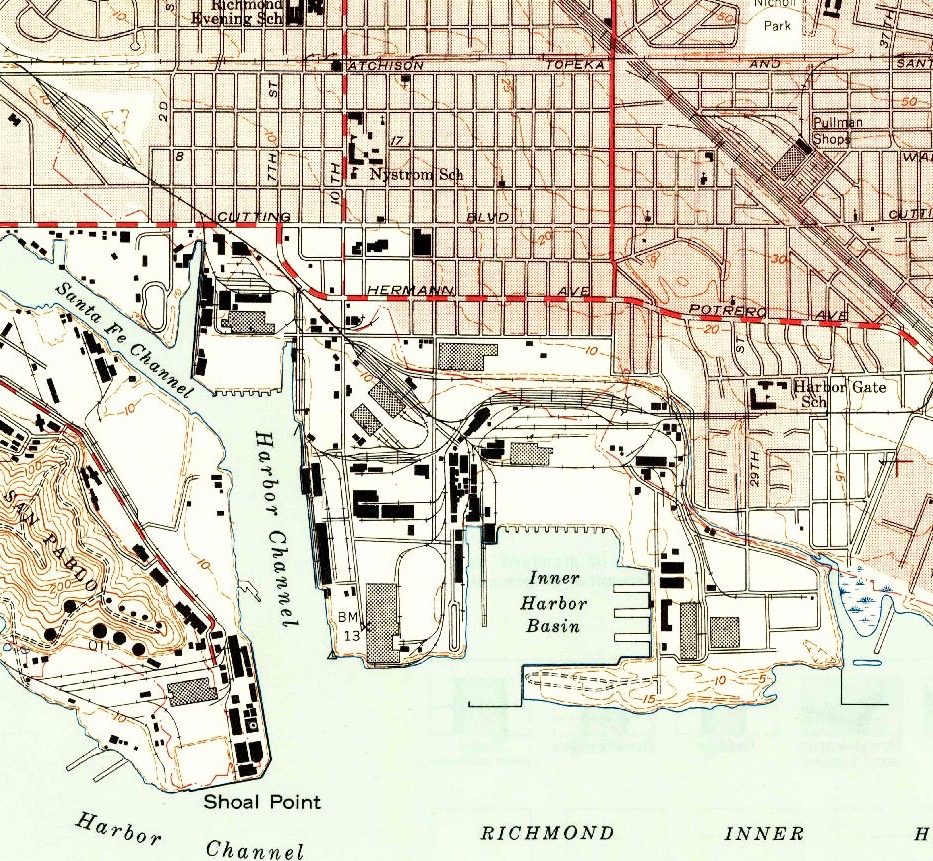Richmond Pacific Railroad on:
[Wikipedia]
[Google]
[Amazon]
The Richmond Pacific Railroad is a

 The PRT was incorporated in July 1950 as a terminal railroad to take over the private railroad of Parr-Richmond Industrial Corporation. In 1911, Terminal 1 was constructed as the primary port of the Port of Richmond. In the 1930s the City of Richmond entered an agreement with the Parr Company to operate the terminal. The terminal area was primarily used to unload
The PRT was incorporated in July 1950 as a terminal railroad to take over the private railroad of Parr-Richmond Industrial Corporation. In 1911, Terminal 1 was constructed as the primary port of the Port of Richmond. In the 1930s the City of Richmond entered an agreement with the Parr Company to operate the terminal. The terminal area was primarily used to unload
terminal railroad
A switching and terminal railroad is a freight railroad company whose primary purpose is to perform local switching services or to own and operate a terminal facility.
Switching is a type of operation done within the limits of a yard. It gener ...
owned by the Levin-Richmond Terminal Corporation. The RPRC operates on of track in the shipping terminal and wharves at Richmond, California
Richmond is a city in western Contra Costa County, California, United States. The city was municipal corporation, incorporated on August 3, 1905, and has a Richmond, California, City Council, city council.
.
The RPRC also interchanges with the Union Pacific
The Union Pacific Railroad is a Class I freight-hauling railroad that operates 8,300 locomotives over routes in 23 U.S. states west of Chicago and New Orleans. Union Pacific is the second largest railroad in the United States after BNSF, ...
(UP) and BNSF Railway
BNSF Railway is the largest freight railroad in the United States. One of six North American Class I railroads, BNSF has 36,000 employees, of track in 28 states, and over 8,000 locomotives. It has three Transcontinental railroad, transcontine ...
(BNSF). The shipping tariff is a flat rate of $210 per car or $310 per hazardous material car. The railroad operates two shifts, between 6 a.m. - 10 p.m. The railroad switches about 3,250 cars per year.
The RPRC was formerly known as the Parr Terminal Railroad .
History

 The PRT was incorporated in July 1950 as a terminal railroad to take over the private railroad of Parr-Richmond Industrial Corporation. In 1911, Terminal 1 was constructed as the primary port of the Port of Richmond. In the 1930s the City of Richmond entered an agreement with the Parr Company to operate the terminal. The terminal area was primarily used to unload
The PRT was incorporated in July 1950 as a terminal railroad to take over the private railroad of Parr-Richmond Industrial Corporation. In 1911, Terminal 1 was constructed as the primary port of the Port of Richmond. In the 1930s the City of Richmond entered an agreement with the Parr Company to operate the terminal. The terminal area was primarily used to unload crude oil
Petroleum, also known as crude oil or simply oil, is a naturally occurring, yellowish-black liquid chemical mixture found in geological formations, consisting mainly of hydrocarbons. The term ''petroleum'' refers both to naturally occurring u ...
from ships into storage tanks that supplied the local oil refineries
An oil refinery or petroleum refinery is an industrial process plant where petroleum (crude oil) is transformed and refined into products such as gasoline (petrol), diesel fuel, asphalt base, fuel oils, heating oil, kerosene, liquefied pet ...
. It also was used to transfer ship cargo to rail cars. The terminal was used as a ferry
A ferry is a boat or ship that transports passengers, and occasionally vehicles and cargo, across a body of water. A small passenger ferry with multiple stops, like those in Venice, Italy, is sometimes referred to as a water taxi or water bus ...
terminal prior to the opening of the Golden Gate Bridge
The Golden Gate Bridge is a suspension bridge spanning the Golden Gate, the strait connecting San Francisco Bay and the Pacific Ocean in California, United States. The structure links San Francisco—the northern tip of the San Francisco Peni ...
.
During World War II
World War II or the Second World War (1 September 1939 – 2 September 1945) was a World war, global conflict between two coalitions: the Allies of World War II, Allies and the Axis powers. World War II by country, Nearly all of the wo ...
the U.S. military created the Parr-Richmond Terminal Military Reservation. The military reservation was created as the result of a lease of dated April 19, 1943 at the Parr terminal area. The location was used to support World War II efforts and as warehouse/storage for military shipping at the Port of San Francisco.
References
* * * *Further reading
* List of California railroads *''Pacific Rail News'', May 1996 issue. Switching and terminal railroads California railroads Companies based in Richmond, California Defunct California railroads {{California-transport-stub